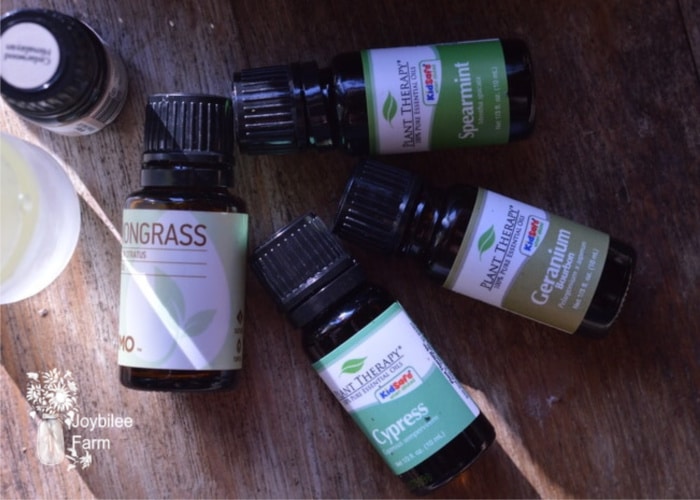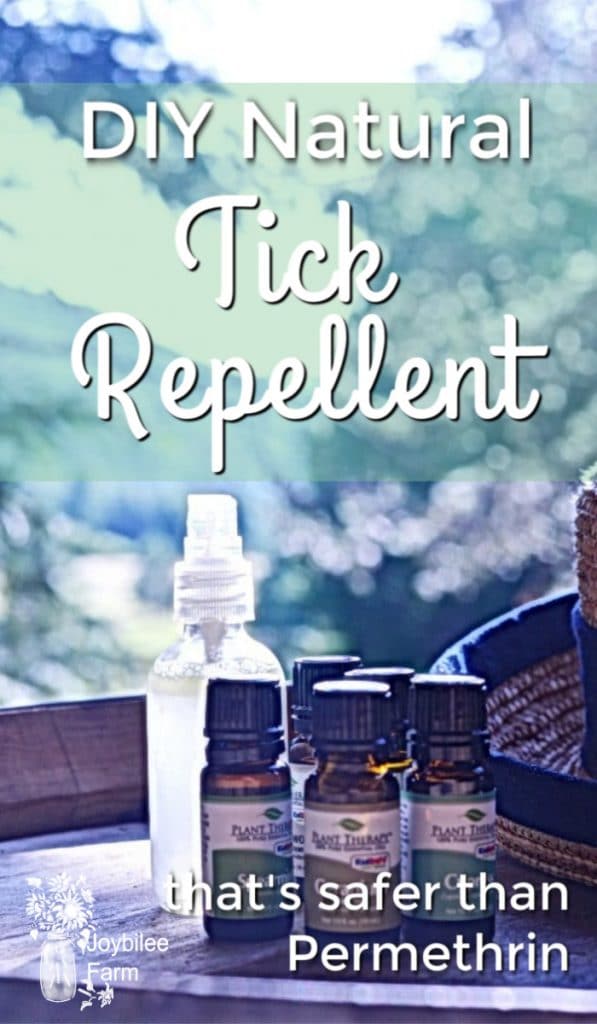Skip the chemicals and use this natural tick repellent that you make at home. Tick exposure can occur year-round, but ticks are most active during warmer months (April-September).
Ticks can be a real problem around our homestead. They are not only a hazard to our family but also our farm dogs. I’ve created a recipe that keeps them at bay without the harsh chemicals that may have questionable effects on our systems.
Be proactive and learn about how to control ticks, how to prevent them from hanging out in your yard, and how to make a natural tick repellent that is healthy. Don’t let the fear of exposure to ticks keep you from going outdoors and enjoying the summer.
Treat for Ticks Before You Go Outdoors
Know where to expect ticks before you get there. Ticks live in grassy, brush, or wooded areas, or even on animals. You are likely to be exposed while spending time outside walking your dog, camping, gardening, or hunting. Most outdoor activities could bring you in close contact with ticks. It is not necessary to go into the wilderness to be exposed, many people and animals get ticks in their own yard or in their neighborhood.
Avoid Contact with Ticks. One way to steer clear of ticks is to avoid wooded and brush areas with high grass and leaf litter. If you plan to go on a hike, walk in the center of trails and not through the brush. Use this link for the CDC to know which ticks are most common in your area.
Wear closed-toe shoes, long sleeves, and pants when going into areas that might have ticks.
For added protection while hiking, tuck your shirt into your pants, and your pants into your socks.

Use Tick Prevention to Create a Tick-safe Zone in the Yard
The Connecticut Agricultural Experiment Station has developed a comprehensive Tick Management Handbook for preventing tick bites. There are several simple landscaping techniques that can help reduce tick populations no matter where you live.
- Clear tall grasses and brush around homes and at the edge of lawns.
- Remove leaf litter
- Stack wood neatly and in a dry area to discourage rodents.
- Place a 3-ft wide barrier of wood chips or gravel between lawns and wooded areas to restrict tick migration into recreational areas.
- Mow the lawn frequently.
- Keep playground equipment, decks, and patios away from yard edges and trees.
- Discourage unwelcome animals (such as deer, raccoons, and stray dogs) from entering your yard by constructing fences.
- Remove old furniture, mattresses, or trash from the yard that may give ticks a place to hide.
You CAN Skip the Chemicals, here’s why
The CDC recommends that you treat your clothing and gear with products that contain 0.5% permethrin. Permethrin can be used to treat boots, clothing and camping gear and will remain protective through several rounds of washings. Alternatively, you can buy permethrin-treated clothing and gear. According to the General Fact Sheet for Permethrin:
Permethrin can affect insects if they eat it or touch it. Permethrin affects the nervous system in insects, causing muscle spasms, paralysis and death. Permethrin is more toxic to insects than it is to people and dogs. This is because insects can’t break it down as quickly as people and dogs. Cats are more sensitive to permethrin than dogs or people because it takes their bodies a long time to break it down.
While that may seem innocent enough, digging deeper we found that
If permethrin gets into the soil, it is broken down by microorganisms. Sunlight may also break down permethrin on the soil surface and on the surface of water. Permethrin does not mix well with water. When permethrin gets into surface water like lakes or streams, it sticks very strongly to sediment and can stay there for more than a year. Since permethrin sticks to sediment and does not mix well with water, it won’t usually contaminate groundwater. Permethrin does not evaporate very easily when it is applied to surfaces. Permethrin was applied indoors near a window in an experiment where it was exposed to daylight. After 20 days, 60% of the permethrin that was applied was still on the surface.
If permethrin is applied to plants, it may stay on the leaves for between 1 and 3 weeks. Scientists applied permethrin to soil and then planted sugar beets, wheat, lettuce and cotton in the soil. Scientists found trace amounts of the permethrin residue in the edible parts of the plants at 30 and 120 days after planting. Trace amounts of permethrin have been found in foods including bananas, collard greens, squash and watermelon. However, less than 1% of the more than 1,700 food samples tested had detectable levels of permethrin.
But the worst part is that
Permethrin is highly toxic to fish and other animals that live in either salt water or fresh water. Permethrin is low in toxicity to birds, but some aerosol products made with permethrin may also contain other ingredients that can harm birds if they inhale it. Permethrin is highly toxic to bees and other beneficial insects.

Dried lavender herb and essential aromatherapy oil
Be Proactive, Check for Ticks After You Come Indoors
Check your clothing for ticks. Ticks may be carried into the house on clothing. Any ticks that are found should be removed. Tumble dry clothes in a dryer on high heat for 10 minutes to kill ticks on dry clothing after you come indoors. If the clothes are damp, additional time may be needed. If the clothes require washing first, hot water is recommended. Cold and medium temperature water will not kill ticks.
Examine gear and pets. Ticks can ride into the home on clothing and pets, then attach to a person later, so carefully examine pets, coats, and day-packs.
Shower soon after being outdoors. Showering within two hours of coming indoors has been shown to reduce your risk of getting Lyme disease and may be effective in reducing the risk of other tick-borne diseases. Showering may help wash off unattached ticks and it is a good opportunity to do a tick check.
Can you identify a black-legged tick?
Generally, people are infected through the bite of immature ticks called nymphs that are about the size of a poppy seed. Adult ticks (about the size of a sesame seed) can also transmit Lyme disease. Ticks are very small and their bites are usually painless, so you may not know you’ve been bitten. Canada Public Health has details about what to do if you are bitten. Be sure to download their pamphlet and be ready before you go on your next outing.
Check your body for ticks after being outdoors.

photo courtesy of the CDC
Conduct a full-body check upon return from potentially tick-infested areas, including your own backyard. Use a hand-held or full-length mirror to view all parts of your body. Check these parts of your body and your child’s body for ticks:
- Under the arms
- In and around the ears
- Inside belly button
- Back of the knees
- In and around the hair
- Between the legs
- Around the waist
- Symptoms of Tick-borne illness from the Center for Disease Control

DIY Natural Tick Repellent that’s Safer than Permethrin
- Prep Time: 5 mins
- Total Time: 5 minutes
- Yield: 4 ounces 1x
- Category: Essential Oils
Description
Skip the chemicals and use this natural tick repellent that you make at home. Tick exposure can occur year-round, but ticks are most active during warmer months (April-September).
Ingredients
- 5 drops spearmint essential oil
- 10 drops lemon grass essential oil
- 20 drops geranium bourbon essential oil
- 20 drops cedarwood virginian essential oil
- 20 drops cypress essential oil
- 4 ounces aloe vera gel or vodka
- a 4-ounce bottle with spray top
Instructions
- Measure the essential oils by drops, adding them to the bottle
- Top up the bottle with the vodka or aloe vera gel
- Cap with the spray top
- Shake before each use
Notes
Usage Directions for essential oil tick repellant
Spray Natural Tick Repellant on clothing
Spray on body
Spray 5 minutes before going outdoors
Reapply every 2 to 3 hours.
Use as a natural tick repellent for dogs
For use with children under 6
Replace the lemongrass in the recipe with equal parts tea tree essential oil for a kid-safe version of this DIY natural tick repellent.
Natural Tick Repellent Recipe with Essential Oils 3% Dilution
Ingredients
- a 4-ounce bottle with spray top
- 5 drops spearmint essential oil
- 10 drops lemon grass essential oil
- 20 drops geranium bourbon essential oil
- 20 drops cedarwood virginian essential oil
- 20 drops cypress essential oil
- 4 ounces aloe vera gel, witch hazel, or vodka
Directions
- Measure the essential oils by drops, adding them to the bottle
- Top up the bottle with the vodka, witch hazel, or aloe vera gel
- Cap with the spray top
- Shake before each use
Usage Directions for essential oil tick repellent
- Spray Natural Tick repellent on clothing
- Spray on body
- Spray 5 minutes before going outdoors
- Reapply every 2 to 3 hours.
- Use as a natural tick repellent for dogs
For use with children under 6
Replace the lemongrass in the recipe with equal parts tea tree essential oil for a kid-safe version of this DIY natural tick repellent.
Get educated about ticks and the damage they can do to your health. Make sure you have a supply of natural tick repellent on hand to ward off trouble. You’ll be glad you did.
Check out my easy mosquito repellent recipe that you can make in 2 minutes or less.
Reference:
https://www.cdc.gov/lyme/prev/natural-repellents.html





Would this be as effective with being put into a salve form? Or do you think it would limit the effects?
Its worth a try.